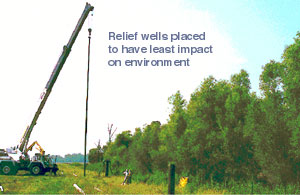Relief wells control levee seepage while saving land and money

The new method was designed and installed at Fitler, MS, by the Vicksburg District of the U.S. Army Corps of Engineers, which won an award for it in the annual Chief of Engineers Design and Environmental Awards Program.
In addition to saving costs, the system of relief wells reduces the need to excavate environmentally sensitive lands on the riverbank traditionally required in order to provide material for earthern berms.

Large earthen levees are constructed along the banks of the Misissippi River to prevent floodwaters from entering adjacent states. "Sometimes these levees have problems with water seeping underneath," said C. C. Hamby of the district's design branch.
Original plan would have necessitated clearing 500 acres of black bear habitat
The reach of the levee at Fitler, which is known as the Tallula-Magna Vista reach, has a history of underseepage problems and is considered prime black bear habitat. "The original plan of constructing a berm called for clearing approximately 500 acres of timberland," Hamby said. "Instead of constructing berms, we elected to install relief wells (using) an innovative method of installing wells," said Hamby.
The Corps used a vibratory hammer to drive an outer casing to the desired depth, jetting the material from the casing, installing the well screen and filter and using the hammer to remove the outer casing.
"We estimate 275 acres of forest were saved because no borrow material was required," Hamby said. "Also, an additional 100 acres of forest and wetland were saved, since no soil berms were required."
Final costs were less than half of traditional methods
Economic benefits were significant. The final cost of the relief wells was $1.8 million, a savings of approximately two million dollars for previous methods.
Corps officials are certain the new process represents a win-win situation for those protected by the levee and environmental champions.
